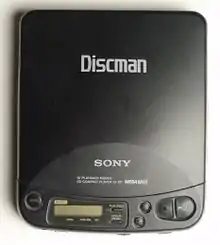Portable CD player
A portable CD player is a portable audio player used to play compact discs. The first audio player released was the Discman D-50 by Sony.[1]


Features
The basic features of a portable CD player are:
- Play/Pause
- Stop
- Rewind
- Fast forward
- Hold (some models)
- Liquid crystal display
- Headphone/audio out socket
The play and pause feature allows the user to pause in the middle of the track (song) and resume it at the same place the listener left off at once the play button is hit again. The stop feature stops the track allowing the user to then switch tracks easily. The fast forward and rewind feature will either fast forward or rewind the track the amount of time you hold the button down. The liquid crystal display provides a visual of how much battery is left, what track (number) is currently playing, and the amount of time elapsed on the track. Some portable CD players can play CD-R/CD-RW discs and some can play other formats such as MP3-encoded audio.
The 8 cm CD provides a smaller alternative to the normal 12 cm CD (although with a lower capacity). Miniature players exist that only play this format.
Issues with recordable CDs
Some, mainly earlier portable CD players do not play recordable CDs (CD-R, CD-RW) properly because of the way these CDs are recorded, and due to the significantly lower reflectivity of CD-RW.
A consumer-recorded CD is recorded by making marks in a thin layer of organic dye, which leads to incompatibility with some CD players. For some users of CD-Rs, the solution to this is to burn the CD at a slower speed or use a different brand of recordable CDs.[2]
Future
Portable CD players are declining in popularity since the rise in popularity of Portable media players that play digital audio files including the iPod and smartphones. Before digital audio players became popular, many switched over to MiniDisc as an alternative to CDs, due to the compact size of the MiniDisc format.[3]
See also
References
- Lungu, R. "History of the Portable Audio Player." Archived 2012-05-02 at the Wayback Machine 2008-11-27.
- "CD player won't play my burned cds." 2006-02-17
- Wallop, H. Portable CD players make a comeback 12-07-08.
